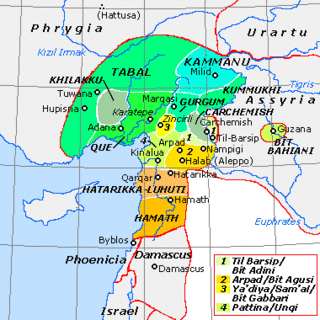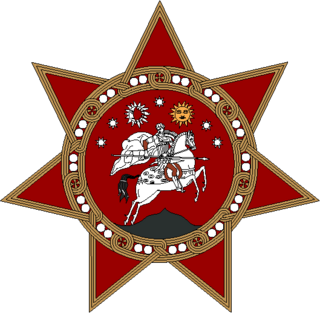Related Research Articles

The Kingdom of Israel, or the Kingdom of Samaria, was an Israelite kingdom in the Southern Levant during the Iron Age. The kingdom controlled the areas of Samaria, Galilee and parts of Transjordan. Its capital, for the most part, was Samaria.

Tiglath-Pileser III, was the king of the Neo-Assyrian Empire from 745 BC to his death in 727. One of the most prominent and historically significant Assyrian kings, Tiglath-Pileser ended a period of Assyrian stagnation, introduced numerous political and military reforms and more than doubled the lands under Assyrian control. Because of the massive expansion and centralization of Assyrian territory and establishment of a standing army, some researchers consider Tiglath-Pileser's reign to mark the true transition of Assyria into an empire. The reforms and methods of control introduced under Tiglath-Pileser laid the groundwork for policies enacted not only by later Assyrian kings but also by later empires for millennia after his death.

Hoshea was the nineteenth and last king of the Israelite Kingdom of Israel and son of Elah. William F. Albright dated his reign to 732–721 BCE, while E. R. Thiele offered the dates 732–723 BCE.
Tiglath-Pileser II was King of Assyria from 967 BCE, when he succeeded his father Ashur-resh-ishi II, until his death in 935 BCE, when he was succeeded by his son Ashur-dan II. Little is known about his reign.

Tiglath-Pileser I was a king of Assyria during the Middle Assyrian period. According to Georges Roux, Tiglath-Pileser was "one of the two or three great Assyrian monarchs since the days of Shamshi-Adad I". He was known for his "wide-ranging military campaigns, his enthusiasm for building projects, and his interest in cuneiform tablet collections". Under him, Assyria became the leading power of the Ancient Near East, a position the kingdom largely maintained for the next five hundred years. He expanded Assyrian control into Anatolia and Syria, and to the shores of the Mediterranean Sea. From his surviving inscriptions, he seems to have carefully cultivated a fear of himself in his subjects and in his enemies alike.

Tabal was a Luwian speaking Neo-Hittite kingdom of South Central Anatolia during the Iron Age. According to archaeologist Kurt Bittel, references to Tabal first appeared after the collapse of the Hittite Empire. Tabal was likely an exonym applied by the Assyrians to Cappadocia. While its native name is uncertain, it is possible that it was called Sura, as mentioned in the records of Yariri, ruler of Carchemish.

Diauehi (Georgian დიაოხი, Urartian Diauehi, Greek Taochoi, Armenian Tayk, possibly Assyrian Daiaeni) was a tribal union located in northeastern Anatolia, that was recorded in Assyrian and Urartian sources during the Iron Age. It is usually (though not always) identified with the earlier Daiaeni(Dayaeni), attested in the Yonjalu inscription of the Assyrian king Tiglath-Pileser I's third year (1118 BC) and in later records by Shalmaneser III (845 BC). While it is unknown what language(s) they spoke, they may have been speakers of a Kartvelian, Armenian, or Hurrian language.
Šamsi was an Arab queen who reigned in the Ancient Near East, in the 8th century BCE. She succeeded Queen Zabibe. Tiglath-Pileser III, son of Ashur-nirari V and king of Assyria, was the first foreign ruler to bring the Arabs under his control. When Šamsi rebelled against him by joining an alliance forged by Rakhianu of Damascus, Pileser attacked and defeated Samsi, made her and her alliance partners surrender, and pay a tribute to remain in power. She ruled for 20 years and her successor was Queen Iatie, in about 700 BC.
Nairi was the Akkadian name for a region inhabited by a particular group of tribal principalities in the Armenian Highlands, approximately spanning the area between modern Diyabakır and Lake Van and the region west of Lake Urmia. Nairi has sometimes been equated with Nihriya, known from Mesopotamian, Hittite, and Urartian sources. However, its co-occurrence with Nihriya within a single text may argue against this.

George XII, sometimes known as George XIII, of the House of Bagrationi, was the second and last King of the Kingdom of Kartl-Kakheti in eastern Georgia from 1798 until his death in 1800.
David of Kakheti was a Choreposcopus of Kakheti, a principality of Eastern Georgia, who ruled from 976 until his death 1010.
The Assyrian conquest of Aram concerns the series of conquests of largely Aramean, Phoenician, Sutean and Neo-Hittite states in the Levant by the Neo-Assyrian Empire. This region was known as Eber-Nari and Aram during the Middle Assyrian Empire and the Neo-Assyrian Empire.

Bit Agusi or Bit Agushi was an ancient Aramaean Syro-Hittite state, established by Gusi of Yakhan at the beginning of the 9th century BC. It had included the cities of Arpad, Nampigi (Nampigu) and later on Aleppo Arpad was the capital of the state-kingdom. Bit Agusi stretched from the A'zaz area in the north to Hamath in the south.

The 1991–1992 Georgian coup d'état, also known as the Tbilisi War, or the Putsch of 1991–1992, was an internal military conflict that took place in the newly independent Republic of Georgia following the fall of the Soviet Union, from 22 December 1991 to 6 January 1992. The coup, which triggered the Georgian Civil War, pitted factions of the National Guard loyal to President Zviad Gamsakhurdia against several paramilitary organizations unified at the end of 1991 under the leadership of warlords Tengiz Kitovani, Jaba Ioseliani and Tengiz Sigua.

The collapse of the Georgian realm was a political and territorial fragmentation process that resulted in the dynastic triumvirate military conflict of the Bagrationi monarchs and war of succession in the united Kingdom of Georgia culminating during the second half of the 15th century.

State Council of the Republic of Georgia was a temporary supreme governing body of the country, which was established in 1992 after the self-liquidation of the Military Council of the Republic of Georgia.
Asya was a ruler of the Kingdom of Diaokhi, a confederation of proto-Georgian tribes, who reigned around the middle of the 9th century BCE. He is known from Assyrian sources describing the military campaigns of Shalmaneser III.
Utuphursi is the last known ruler of the kingdom of Diaokhi, a confederation of proto-Georgian tribes. His reign spanned over three decades during which he faced the expansionist policy of neighboring Urartu. He fought several battles against kings Menua and Argishti I in the first half of the 8th century BCE. His reign is documented through Urartian texts.
Ali ibn Shuab al-Tiflis was a leader of the Emirate of Tiflis, an Arab state in Georgia that reigned from 829 to 833. A member of the Shuabid dynasty, he was a subject of the Abbasid province of Arminiya and was appointed to replace a rebellious emir. His short reign was marked by the continuation of Tiflis's conflict with Christian Georgia.
References
- ↑ Asatiani & Janelidze 2009, p. 15.
- 1 2 3 4 5 Rawlinson 1901, p. 221.
- ↑ Asatiani & Bendianashvili 1997, p. 31.
- ↑ Ahman 2017, p. 32.